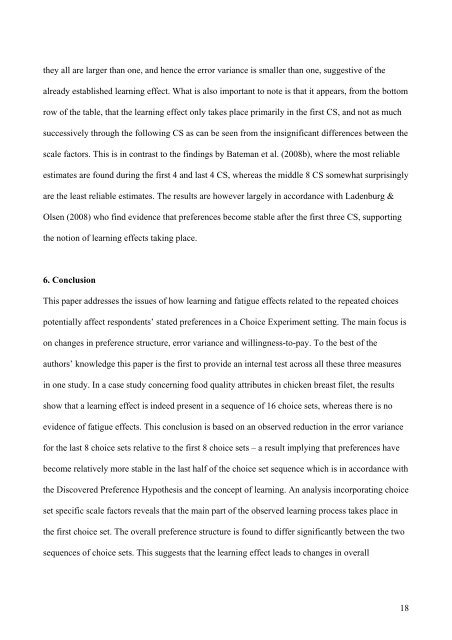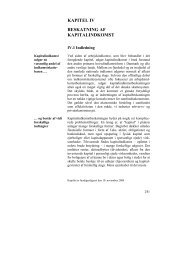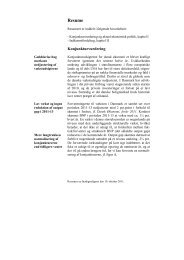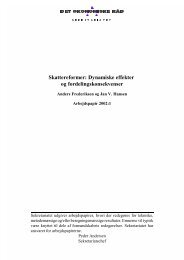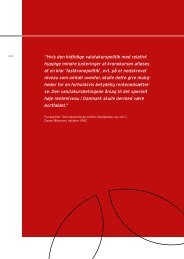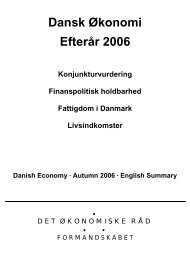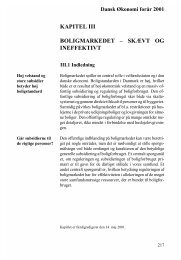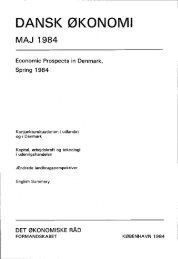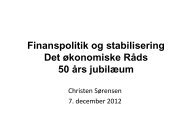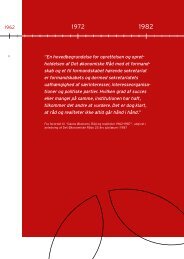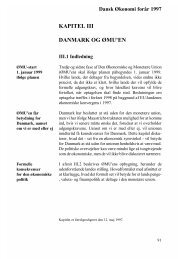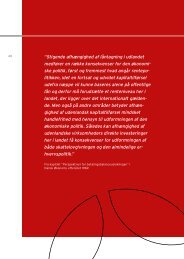The Effect of Learning and Fatigue on Preferences and WTP in a ...
The Effect of Learning and Fatigue on Preferences and WTP in a ...
The Effect of Learning and Fatigue on Preferences and WTP in a ...
Create successful ePaper yourself
Turn your PDF publications into a flip-book with our unique Google optimized e-Paper software.
they all are larger than <strong>on</strong>e, <str<strong>on</strong>g>and</str<strong>on</strong>g> hence the error variance is smaller than <strong>on</strong>e, suggestive <str<strong>on</strong>g>of</str<strong>on</strong>g> the<br />
already established learn<strong>in</strong>g effect. What is also important to note is that it appears, from the bottom<br />
row <str<strong>on</strong>g>of</str<strong>on</strong>g> the table, that the learn<strong>in</strong>g effect <strong>on</strong>ly takes place primarily <strong>in</strong> the first CS, <str<strong>on</strong>g>and</str<strong>on</strong>g> not as much<br />
successively through the follow<strong>in</strong>g CS as can be seen from the <strong>in</strong>significant differences between the<br />
scale factors. This is <strong>in</strong> c<strong>on</strong>trast to the f<strong>in</strong>d<strong>in</strong>gs by Bateman et al. (2008b), where the most reliable<br />
estimates are found dur<strong>in</strong>g the first 4 <str<strong>on</strong>g>and</str<strong>on</strong>g> last 4 CS, whereas the middle 8 CS somewhat surpris<strong>in</strong>gly<br />
are the least reliable estimates. <str<strong>on</strong>g>The</str<strong>on</strong>g> results are however largely <strong>in</strong> accordance with Ladenburg &<br />
Olsen (2008) who f<strong>in</strong>d evidence that preferences become stable after the first three CS, support<strong>in</strong>g<br />
the noti<strong>on</strong> <str<strong>on</strong>g>of</str<strong>on</strong>g> learn<strong>in</strong>g effects tak<strong>in</strong>g place.<br />
6. C<strong>on</strong>clusi<strong>on</strong><br />
This paper addresses the issues <str<strong>on</strong>g>of</str<strong>on</strong>g> how learn<strong>in</strong>g <str<strong>on</strong>g>and</str<strong>on</strong>g> fatigue effects related to the repeated choices<br />
potentially affect resp<strong>on</strong>dents’ stated preferences <strong>in</strong> a Choice Experiment sett<strong>in</strong>g. <str<strong>on</strong>g>The</str<strong>on</strong>g> ma<strong>in</strong> focus is<br />
<strong>on</strong> changes <strong>in</strong> preference structure, error variance <str<strong>on</strong>g>and</str<strong>on</strong>g> will<strong>in</strong>gness-to-pay. To the best <str<strong>on</strong>g>of</str<strong>on</strong>g> the<br />
authors’ knowledge this paper is the first to provide an <strong>in</strong>ternal test across all these three measures<br />
<strong>in</strong> <strong>on</strong>e study. In a case study c<strong>on</strong>cern<strong>in</strong>g food quality attributes <strong>in</strong> chicken breast filet, the results<br />
show that a learn<strong>in</strong>g effect is <strong>in</strong>deed present <strong>in</strong> a sequence <str<strong>on</strong>g>of</str<strong>on</strong>g> 16 choice sets, whereas there is no<br />
evidence <str<strong>on</strong>g>of</str<strong>on</strong>g> fatigue effects. This c<strong>on</strong>clusi<strong>on</strong> is based <strong>on</strong> an observed reducti<strong>on</strong> <strong>in</strong> the error variance<br />
for the last 8 choice sets relative to the first 8 choice sets – a result imply<strong>in</strong>g that preferences have<br />
become relatively more stable <strong>in</strong> the last half <str<strong>on</strong>g>of</str<strong>on</strong>g> the choice set sequence which is <strong>in</strong> accordance with<br />
the Discovered Preference Hypothesis <str<strong>on</strong>g>and</str<strong>on</strong>g> the c<strong>on</strong>cept <str<strong>on</strong>g>of</str<strong>on</strong>g> learn<strong>in</strong>g. An analysis <strong>in</strong>corporat<strong>in</strong>g choice<br />
set specific scale factors reveals that the ma<strong>in</strong> part <str<strong>on</strong>g>of</str<strong>on</strong>g> the observed learn<strong>in</strong>g process takes place <strong>in</strong><br />
the first choice set. <str<strong>on</strong>g>The</str<strong>on</strong>g> overall preference structure is found to differ significantly between the two<br />
sequences <str<strong>on</strong>g>of</str<strong>on</strong>g> choice sets. This suggests that the learn<strong>in</strong>g effect leads to changes <strong>in</strong> overall<br />
18


